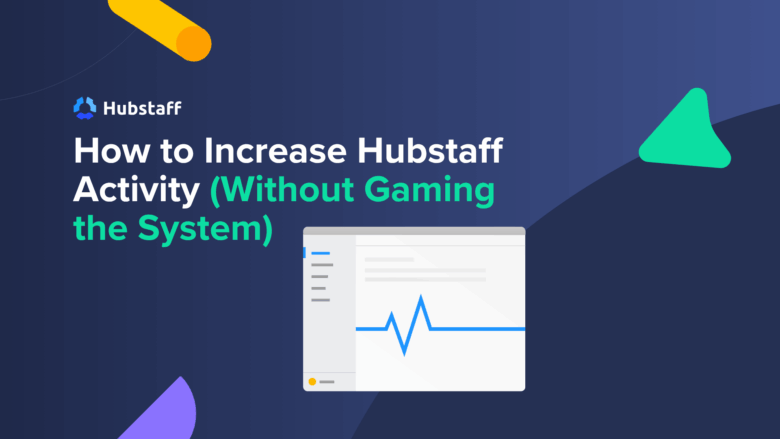When people search “the proper solution to improve Hubstaff train,” they sometimes chase completely totally different aims.
Some staff merely want to extend the amount, they normally even resort to strategies like fake mouse train jigglers to create false train.
Others try to know what that amount actually means, how and when to rely on it, and the best way it ties into broader company-wide aims.
This put up is for the second group — those that use Hubstaff time monitoring and train on account of they care about output.
Hubstaff’s train metric tracks mouse and keyboard train, which can mirror engagement nevertheless not on a regular basis employee productiveness. Utilized in context, it’s a useful signal. Misused, it’s a distraction.
We’ll make clear what train costs really measure, why they differ all through roles, and the proper solution to improve them to assist precise work.
Improve your crew’s effectivity with Hubstaff’s productiveness devices
What’s Hubstaff train, really?
Hubstaff’s train metric measures how sometimes a crew member makes use of their mouse and keyboard all through tracked time.
Hubstaff calculates train as a proportion based on enter all via 10-minute blocks. The additional enter, the higher the train worth.
This makes it benchmark for engagement, nevertheless it doesn’t seize each half. That doesn’t suggest Hubstaff’s train metric isn’t a helpful gizmo. Nonetheless, it could be misleading within the occasion you’re looking at it with out context.
| What Hubstaff train displays | What Hubstaff train doesn’t current |
| – Frequency of keyboard movement (not keylogging of explicit keys)
– Mouse actions – Frequency of interaction inside apps – Patterns of energetic vs. idle time all through the day |
– Contemplating, planning, or offline problem-solving
– Strategic work that doesn’t include enter (e.g., reviewing, learning, sketching) – Output prime quality |
Train monitoring shows interaction, not effort or affect. To get precise price from it, it is necessary to understand how each crew member matches into the bigger picture.
Why train scores is also low (and why it’s okay)
A low train ranking doesn’t on a regular basis suggest anyone isn’t working.
Oftentimes, it merely means they’re working in one other approach. Not every operate generates mounted mouse and keyboard enter, and that’s fully common.
Many workflows rely on pondering, learning, planning, or asynchronous communication, all involving precise effort nevertheless little trackable enter. Chasing elevated numbers with out understanding the context can merely consequence within the flawed conclusions.
Listed under are a few examples of how train can differ by operate:
- Developer debugging code. Train could dip 30 to 40% all through heavy learning, coding certifications, and totally different non-code-related duties.
- Problem supervisor on calls and Slack. Normally 25 to 35% whereas actively major calls.
- Purchaser assist agent in helpdesk software program program. Prices usually hit 65 to 85% as a consequence of mounted dwell chat or chatbot correspondence.
- Graphic designer in Figma. Train may current 35 to 45% train whereas visually centered nevertheless not repeatedly clicking.
- Marketer writing or researching. Attributable to prolonged durations of learning or writing, train can differ between 40% and 60%.
- Product sales rep. Product sales teams may shut presents over the phone or in particular person with out interacting with their mouse and keyboard the least bit.
As you might even see, the very very last thing you have to do is to set a standard scale in your full group, as job options and day-to-day duties differ drastically. No one wins on this state of affairs.
The best managers work to know their staff’ day-to-day job options by way of one-on-ones, stand-ups, and Slack check-ins. They acknowledge how job duties differ for numerous positions, and even inside explicit particular person and departmental workloads.
Strict train benchmarks can destroy employee engagement. Instead, set and speak clear operate expectations alongside along with your distant teams, then use the train to assist these expectations.
The way in which to reinforce important train (legitimately)
Hubstaff presents you a window into how work will get completed, nevertheless it’s solely a software program. It acquired’t improve productiveness ranges besides you use that info entry for larger administration — not as a full-on replacement.
If you happen to occur to cope with train scores as a result of the aim, you will miss the aim — and presumably harm your crew’s focus throughout the course of.
Bettering precise output is what lifts train sustainably. Listed under are some strategies to assist that:
- Educate your crew on what Hubstaff tracks. Assure they know Hubstaff tracks info like app and URL utilization and keyboard and mouse train, not full effort or time on-line.
- Assist centered work intervals. Encourage time administration methods like time blocking or deep work. Flip off notifications all through deep work blocks.
- Restore blockers and delays in your workflows. Set clear householders and deadlines to steer clear of work sitting in limbo.
- Make duties seen. Use a enterprise administration software program or course of board and have crew members monitor time on to duties. Our native course of administration decision, Hubstaff Duties, makes this easier to deal with.
- Shorten idle thresholds. Regulate Idle time settings to reflect exact downtime vs. heads-down work that doesn’t require enter.
- Overcommunicate. Encourage your crew to speak up about what’s unclear—expectations, priorities, blockers, and subsequent steps. The additional that can get acknowledged out loud, the a lot much less time is misplaced to quiet confusion.
- Detailed tales. Look previous productiveness ranges to produce tales that current how clients are literally spending their time.
Your entire degree of these isn’t to squeeze further out of your crew. Instead, it’s developing an environment that’s conducive to raised work.
What to not do
Let’s merely say that within the occasion you’re questioning whether or not or not people have came upon strategies to artificially “improve” their Hubstaff train, they’ve.
Auto-clickers, train simulators, and idle blockers are easy to hunt out.
Nevertheless using them doesn’t improve productiveness. It merely breaks perception, muddles the data, and masks precise factors that must be surfaced and glued.
This isn’t a gray area. Faking train is misuse, plain and simple.
Further importantly, though, it’s sometimes a sign that one factor deeper is off:
- Poor communication
- Unclear expectations
- A practice of concern spherical metrics
If people actually really feel the need to pad their time or simulate enter, the problem isn’t an absence of monitoring. Instead, one could argue that there’s one factor flawed with how your crew runs at a foundational diploma.
Greater function: Use train to establish developments, not micromanage
Hubstaff’s train costs aren’t designed to pit distant staff in opposition to one another.
It’s far more useful as part of a good greater picture, exhibiting how your crew works over time, the place they’re centered, and the place they may want help.
Instead of fixating on explicit particular person dips, use Hubstaff Insights to hint patterns that really matter:
- Monitor developments, not moments. Use the Highlights widget to quickly spot train, hours, or engagement changes — with out digging by way of info.
- Stability workloads with time targets. Set actual wanting work-hour aims to help forestall overwork or underutilization.
- Pair train with output. Monitor course of completion, shopper satisfaction, enterprise velocity, and train costs to get a further full view of effectivity.
- Decide distractions and blockers. Use work classification to see how time is spent and whether or not or not the work is focused or fragmented.
- Trim pointless conferences. Use meeting insights to establish unproductive conferences and time drains and alter communication practices to increase centered work.
- Consider in opposition to benchmarks. Consider commerce and job-specific norms to establish the place your crew may very well be stretched too skinny, under-supported, or working in one other approach for larger employee engagement and work-life stability.
- Spot unusual train. Even with a healthful emphasis on train and hours, some clients nonetheless exploit time monitoring packages like Hubstaff with mouse jigglers, train simulators, and false time monitoring software program program. The bizarre train attribute can help you see irregularities which is able to level out a client is simulating human train.
If you happen to occur to make use of train info to start larger conversations instead of leaping to conclusions, it turns into one factor useful fairly than one factor people try to work spherical.
Conclusion
Train metrics are just one piece of the puzzle.
They don’t current effort, outcomes, or context. Nonetheless, they are going to highlight patterns worth taking note of. When used correctly, they supply assist to understand how work is definitely getting completed and open up larger conversations alongside along with your crew.
Don’t objective for elevated numbers merely to essentially really feel resembling you’re in administration. That kind of pressure solely ends in surface-level enhancements (or, worse, fake ones). Instead, cope with developing a crew that understands what good work looks as if, has the home to do it, and is conscious of they’re being measured fairly.
Source link








I like how you presented this so neatly.